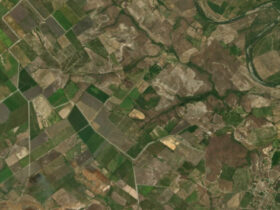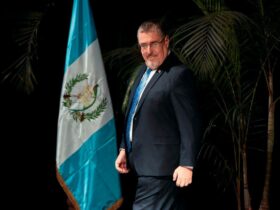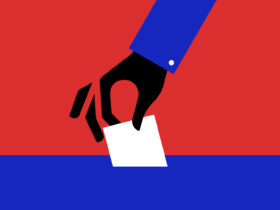By: Carmen Santiago-Urbauer and Hannah Keenan
With the fast-approaching presidential elections, the potential for a new U.S. foreign policy era is on the horizon. Regardless of who wins the presidency, election politics have the power to influence the United States’ next grand strategy. For President Donald Trump, the election represents a chance for him to reassess which issues resonate with his political supporters and design a new foreign policy agenda accordingly. Former Vice President Joe Biden’s candidacy represents the potential for a “return to normalcy” in domestic and international politics‒ a return to the liberal international order. Come what may, it is clear that changes to the U.S.’ international strategy are necessary to overcome the imminent challenges presented by climate change, hyper-globalization, and the COVID-19 pandemic.
In order to envision the future of U.S. foreign policy, we must understand the transformative changes that occurred during this presidency. Below is an overview of the key issues and developments in U.S. foreign policy under President Trump.
China
Trump’s relations with China have been nothing short of tumultuous. Early in his presidency, he strived for friendly relations by recognizing the One China Policy in 2017 after meeting with President Xi Jinping. After Trump described the two nations as “cooperative partners”, U.S.-China relations seemed encouraging, with the hopes of engaging in future bilateral agreements. Further amiability was established when Xi visited Trump in Mar-a-Largo to discuss the expansion of trade and how to suppress North Korea’s nuclear aggression.
Relations turned sour in 2018 when the Trump administration suspected China of stealing U.S. technology and intellectual property, resulting in tariffs on more than $500 billion worth of Chinese imports. China responded with retaliatory tariffs, signaling an upcoming trade war. In July 2018, Trump increased tariffs on Chinese imports by 25%, with China swiftly attacking the U.S.’ agricultural and industrial sectors by equivalently increasing tariffs. Trump’s condemnation of China was made evident when the Chief Financial Officer of Huawei Technologies, Meng Wanzhou, was arrested in Canada under U.S. orders in December 2018. Wanzhou was charged with fraud after she aided Huawei in evading U.S. sanctions against Iran. The U.S. also urged other countries to refrain from using Huawei 5G technology, voicing concerns about major security threats. Huawei was then added to the U.S. Commerce Department’s foreign entity blacklist.
In November 2019, the United States accused China of manipulating its currency in order to gain an unfair advantage in the global market, disregarding its G20 commitment to refrain from competitive devaluation. However, the U.S.-China trade war slowly deescalated as Trump and Chinese Vice Premier Liu He signed the ‘Phase One’ trade deal to reduce tariffs on Chinese imports and protect U.S. intellectual property.
As tensions seemed to be easing, coronavirus undermined the progress of U.S.-China relations, with Trump condemning the CCP’s failure to control the so-called “Chinese Virus.” The Trump administration’s future relations with China look bleak, which was personified in Secretary of State Mike Pompeo’s speech “Communist China and the Free World’s Future,” declaring China a totalitarian, Marxist-Leninist regime. Unless the next president can negotiate fair trade conditions between the two countries and revive friendly relations, U.S. cooperation with the CCP remains a distant prospect.
North Korea
North Korea remains one of Trump’s biggest adversaries. In 2017, North Korea fired ballistic missiles into the Pacific, detonating a thermonuclear bomb. The U.S. has taken a hardline approach to North Korea’s growing nuclear power, threatening to unleash “fire and fury.” In an effort to establish diplomatic ties, Trump met with Kim Jong Un in 2018 to offer legitimacy to his regime. This meeting was a success considering North Korea expressed its commitment to pursuing denuclearization. Yet, a second meeting in 2019 indicated that North Korea could not agree on plans to establish peaceful relations and denuclearize. The Trump administration did not accept Jong Un’s refusal to cooperate and requested they transfer nuclear weapons to the U.S. in exchange for relieving sanctions. If U.S. negotiators were unable to grant sufficient concessions to North Korea, they threatened to surprise the U.S. with a “Christmas gift,” raising alarms of a nuclear attack. Ultimately, no attack ensued, but tensions have increased.
If Trump is reelected, officials suggest that efforts at diplomacy will be pursued. Diplomacy, however, cannot be reached without his administration applying the utmost economic and political pressure on Jong Un’s regime.
Asia-Pacific
Trump started off on the wrong foot in the Asia-Pacific when he withdrew from the Trans-Pacific Partnership (TPP) shortly after his inauguration in January 2017. The agreement — which included the United States, Mexico, Japan, Vietnam, New Zealand, Australia, Peru, Chile, Malaysia, Singapore, and Brunei — was established under the Obama Administration; it was expected to positively contribute to U.S. economic growth and political influence in several regions. Trump’s withdrawal from the trade deal conforms with his grand strategy of emphasizing bilateral relations while shifting away from multilateral cooperation. This move towards bilateral relations also allows Trump to pursue his stern policies for trade with Asian countries.
Yet, despite the U.S.’ withdrawal from TPP, the country’s relations with countries in the Asia-Pacific have prospered throughout Trump’s presidency, with the exception of China and North Korea. Trump has managed to counterbalance his tough position on trade by providing military and political support to Asian allies.
In India, Trump ended the country’s preferential trade status in June 2019, citing that India had not provided “equitable and reasonable access to its markets.” Despite this, the Indian government stated that it would continue to “build on [its]strong ties with the US, both economic and people-to-people.” Throughout this presidency, U.S.-India relations have strengthened, which is not surprising given the similarities between Trump and President Modi’s character and political tactics. In particular, the U.S.-India defense partnership has grown with the Communications Compatibility and Security Agreement (COMCASA) signed in September 2018, which granted India access to U.S. communication technology and allowed for instant communication between the two countries’ militaries.
In other Southeast Asian countries, Trump has been using his trade policy toolbox to achieve political and economic aims, as evidenced by his suspension of $1.3 billion in trade preferences in Thailand and threats to place tariffs on trade with Vietnam. Despite these trade animosities, Trump has maintained strong relationships with Asian allies and, in particular, has cozied up to Asia’s quasi-authoritarian leaders, notably Thai Prime Minister Prayuth Chan-o-cha and Philippines President Rodrigo Duterte.
European Union
Trump perceives the European Union as a threat to U.S. power in the international political economy. As a result, U.S.-EU relations have not been as cooperative over the last four years. The U.S. has advised the EU to respond more aggressively towards Beijing due to major security concerns and one-sided trade practices, yet failed to secure any EU sanctions. Trump’s policies have little legitimacy in the EU’s eyes, considering major disputes over the Iran Nuclear Deal, military spending, peace building in the Middle East, and the U.S.’ abandonment of international organizations, such as the Paris Accords.
As a state-centric leader, Trump praised Britain for safeguarding its sovereignty through Brexit, further diminishing U.S.-EU relations. Britain’s departure from the EU was met with Trump’s promise of free trade deals. Trump even criticized NATO for its lack of counterterrorism efforts, threatening to halt funds to its defense budget and withdraw from the organization as a whole. Despite Trump’s mercantilist view, the House of Representatives recognized the importance of U.S. influence in Europe as they approved the NATO Support Act in 2019.
Contrary to previous presidents who have encouraged further U.S.-EU economic integration, Trump behaves in a Eurosceptic manner, interpreting European prosperity as a U.S. loss. In the U.S. 2019 Trade Policy Agenda, Trump accused some EU member states of implementing unfair trade policies‒ evident in the Boeing-Airbus affair. EU subsidies for Airbus aircraft were met with Trump imposing tariffs on $7.5 billion European imports annually. Despite the fact that the United States runs a substantial trade surplus in services with the EU, Trump continues to act in a transactional, protectionist manner.
Russia
Reports of Russian interference in the 2016 election tainted U.S.-Russia relations for the past four years. Although the U.S. Senate Intelligence Committee collected extensive information, they could not conclude Trump intentionally colluded with Russian operatives to influence the outcome of the election.
The media has portrayed a cordial relationship between Putin and Trump. Trump’s administration, however, has taken a hardline approach to Russian aggression, as demonstrated by the U.S. providing weapons to Ukraine, expelling Russian diplomats, withdrawing from the Open Skies Treaty, and tightening economic sanctions. Trump’s harsh policy stance towards Russia contradicts his refusal to confront Putin’s alleged election interference. Trump also dismissed Russian bounty attacks on U.S. troops in Afghanistan, referring to them as a “hoax.” Trump’s conflicting stances on Russia indicate that he wishes to pursue diplomacy, but only under U.S. terms.
Relations faltered in March of 2018 after two Russian nationals poisoned former Russian spy Sergei Skripal and his daughter in the UK. The chemical agent used was from the Novichok family, which violates the Chemical and Biological Weapons Control and Warfare Elimination Act. Trump penalized Russia by prohibiting loans and other financial assistance to its government. The lack of additional sanctions indicates that Trump is still willing to strengthen diplomatic ties with Russia.
The Middle East
Throughout his presidency, Trump has remained staunchly pro-Israel, and in many regards, seemingly anti-muslim. A week after his presidential inauguration in January 2017, Trump signed an Executive Order that placed a 90-day travel ban on foreign nationals from six predominantly Muslim countries. Nicknamed the “muslim ban,” the executive border additionally prohibited the entry of all Syrian refugees indefinitely. The ban faced continuous challenges from federal courts and Trump signed several additional executive orders in attempts to reinstate and update the ban. In June 2018, the muslim ban 3.0 was upheld by the Supreme Court in a 5-4 ruling and remains in effect today.
The muslim ban is just one manifestation of Trump’s antagonism towards Islamic countries. In December 2017, Trump formally recognized Jerusalem as the capital of Israel and announced plans to move the U.S. embassy from Tel Aviv to the disputed holy city, which is considered sacred within Islam and is duly claimed by Israelis and Palestinians. This move was criticized widely throughout the international system, as it set back the Israeli-Palestinian peace process and raised tensions within the Arab world.
Yet, not all of Trump’s moves in the Middle East have been criticized; in fact, many of them have earned him acclaim. In April 2017, when Trump ordered a missile strike in Syria on the Assad-controlled airbase, in retaliation for President Bashar al-Assad’s use of a chemical weapon on civilians. This attack received mixed reactions from the international community, but in general, was deemed a justified response to the use of chemical weapons by the EU, NATO, and other U.S. allies. This improved Trump’s status in the Arab World, as Arabs on social media showered the president with praise.
Trump continued to scale up U.S. military presence in the Middle East in August 2017, when he announced a counterterrorism campaign in Afghanistan that involved the deployment of more U.S. troops. And, in April 2018, he ordered three additional strikes on military facilities in Syria in cooperation with France and UK forces. Trump solidified his hard stance on U.S. opponents in the Middle East in May 2018 when he announced U.S. withdrawal from the 2015 Joint Comprehensive Plan of Action nuclear agreement with Iran and reinstated sanctions, stating that the agreement did not effectively repress Iran nuclear development and aggression. In October 2018, Trump achieved arguably his most momentous military win when U.S. forces killed Islamic State leader, Abu Bakr al-Baghdadi, thereby “beating ISIS.”
Yet, despite his hard stance on terrorism and its supporters, Trump managed to strike a balance between military action and diplomatic peace efforts in the Middle East. Since December 2018, Trump has been slowly withdrawing U.S. troops from Syria and Afghanistan, while initiating peace talks with various actors in the Middle East. Though, this has by no means been a smooth process. The Middle East Peace Plan proposed in January 2020 by Trump and Israeli Prime Minister Benjamin Netanyahu seeks to end the decades-long Israeli-Palestinian conflict, yet blatantly favors Israel and does not incorporate any Palestinian input. Naturally, this plan has been regarded negatively by Arab states. On the other hand, the U.S.-Taliban agreement signed in February 2020 represents a groundbreaking step towards ending the war in Afghanistan and achieving lasting peace and is supported by the majority of Afghans as well as the greater international community, including NATO, Russia and China.
The Americas
Trump has undone much of the progress on North American multilateral cooperation established in previous presidencies. Given Trump’s anti-immigrant rhetoric, relations with Latin American countries have soured. Mexico-U.S. relations in particular took a big hit at the start of his presidency with Trump’s promise to build a wall along the U.S.-Mexico border and have Mexico pay for it. Yet, despite Trump’s scapegoating and fear-mongering tactics in the media, U.S.-Mexico relations seem to have thrived behind closed doors. In fact, Mexican Foreign Minister Luis Videgaray stated in 2018 that the two countries’ relationship was “closer than it was with previous administrations…that’s a fact of life.”
Similarly, U.S-Canada relations have been relatively edgy with trade disputes and tariffs here and there, but overall amicable. Trump’s renegotiation of the North American Free Trade Agreement (NAFTA), now known as the U.S.-Mexico-Canada Agreement (USMCA), garnered broad bipartisan support in Washington and resulted in various wins and compromises for all three parties. Thus relations between the U.S., Mexico and Canada have remained, for the most part, the status quo.
Yet, Trump’s inflammatory anti-immigrant rhetoric is not just empty words; he has taken substantial action to deter immigration from Central America. In fact, Trump’s immigration agenda has eroded international asylum principles beyond repair. Notably, his Migrant Protection Protocols, better known as the ‘Remain in Mexico’ policy, has violated principles of due process and non-refoulement, while placing hundreds of thousands of asylum-seekers in danger by forcing them to await their hearings in Mexico’s most dangerous cities. Additionally, the U.S. has used its economic and political influence in the Central American region to establish bilateral cooperative asylum agreements with Guatemala, Honduras, and El Salvador, deeming these countries “safe third countries” and thereby requiring migrants apply for asylum when passing through these crime-ridden countries before they apply in the U.S.
As for South America, Trump’s primary foreign policy goals have been to stop the flow of drugs from the region and exert political pressure on Venezuela’s socialist dictatorship through strategic alliances with its neighbors. This strategy of applying maximum pressure on Venezuela involves broad sanctions, which further exacerbates the current economic and humanitarian crisis. These policies have hurt Venezuelan citizens more than the Maduro dictatorship, and many believe the U.S. should trade its hardline stance for a more flexible approach towards democratic transition. Similarly, Trump’s harsh foreign policy agenda in Cuba has drawn criticism for undoing the diplomatic progress achieved in Obama’s presidency by placing sanctions on commerce and tourism as well as ending almost all individual travel to the island.
Africa
Over the past four years, Trump has personally shown little interest in building relations with Africa. But, in order to expand U.S. influence, his administration doubled the amount of American investment in Africa from $29 billion to $60 billion through Prosper Africa. This initiative assists U.S. companies conducting business in Africa, with Sub-Saharan Africa receiving the bulk of foreign direct investments. On top of this, Trump allowed Obama’s Power Africa electrification program and Feed the Future agriculture program to continue unhindered, which is surprising given his pattern of repealing his predecessor’s initiatives.
As for the U.S. political and military agenda in Africa, Trump’s administration has recognized the turmoil many African countries experience, calling for an end to civil strife and authoritarianism. By advocating for strongman Joseph Kabila’s removal in 2019, Trump bolstered the Democratic Republic of Congo’s transition to democracy. Trump has also placed pressure on Cameroon’s autocratic government by scaling back military assistance and kicking Cameroon out of the U.S. preferential trade program in Africa as a response to the government’s human rights violations. Additionally, Trump has also worked with Egypt, Sudan and Ethiopia to mediate negotiations over the latter’s massive dam project on the Nile river. Though some have criticized the U.S. president’s recent decision to cut aid to Ethiopia as impartial, Trump’s efforts have been generally successful in alleviating tensions surrounding the dispute.
Despite the administration’s peace-driven advocacy in Africa, President Trump has repeatedly advocated for cutting aid to the region. The White House’s Office of Management and Budget has proposed several substantial funding cuts to foreign aid, which would disproportionately affect African countries. Fortunately, Congress adamantly opposed these proposals, acknowledging that maintaining foreign aid will promote American ideals of democracy, economic expansion, and security in Africa.
The International Community
Trump’s foreign policy has transformed the United States’ role and reputation in the international system tremendously. In particular, Trump’s presidency brought an end to the US-led liberal international order and ushered in a new era of anti-globalist and protectionist foreign policy. The liberal international institutions established after WW2‒ including the IMF, WB, ICC, UN, WTO, WHO and NATO‒ have maintained a rule-based international system based on economic, financial, political, and military cooperation. Yet, Trump’s “America First” foreign policy objective has directly undermined the legitimacy of this rule-based system by blatantly ignoring international norms and pulling away from multilateral cooperation.
Trump’s first major blow to international cooperation was initiating U.S. withdrawal from the Paris Climate Accords in June 2017, arguing that the voluntary commitment to limit carbon emissions would have hurt the U.S. economically. Fortunately, the international community widely condemned this move and reaffirmed its commitment to the Paris Agreement, representing a significant blow to U.S. international legitimacy and reputation. Unfortunately, even with the majority of the international community on board, the accords are significantly less effective without U.S. support, given that the U.S. accounts for approximately 15% of CO2 emissions, second only to China. Despite Trump’s damage to the U.S. international reputation, the U.S. remains a global leader, and its cooperation on climate change remains critical to securing the future of our planet.
The Paris Agreement is only one of many multilateral commitments Trump has backed out of. The U.S. withdrew from the UN Educational, Scientific and Cultural Organization (UNESCO) and the UN Human Rights Council (UNHRC) in October 2017 and June 2018 respectively, representing a major push towards U.S. unilateralism. Likewise, in May 2020, Trump announced that the U.S. would halt its funding to WHO and terminate its relationship with the organization, a move that could have a significant negative impact on global health efforts, especially in the midst of the COVID-19 pandemic.
Trump has taken a slightly more moderate approach to his policies towards the International Monetary Fund and the World Bank. Though his protectionist “America First” rhetoric has certainly caused tensions, cuts to U.S. funding of both organizations have been much more moderate than expected. This could be related to the fact that China is more than ready to fill the U.S. global leadership vacuum, and both the IMF and the World Bank have expressed interest in collaborating with the rising superpower as it emerges as a major shareholder in these international financial institutions.
As for the North Atlantic Treaty Organization (NATO), Trump has publicly criticized the organization and its members throughout the entirety of his presidency, demanding that its members pay their “fair share.” Many former U.S. national security officials believe that Trump may end U.S.-NATO membership if he is re-elected for a second term, a move that would put Europe’s security at risk to Russian aggression.
Overall, Trump’s self-described “principled realism” continues to threaten much of the multilateral progress established by his predecessors. Though whether Trump has failed or succeeded through his foreign policy is a matter of opinion, there is no denying that international cooperation has been eroded as a result of his presidency. Ultimately, U.S. foreign policy in the last four years serves as a reflection of Americans’ growing ethnonationalism and antiglobalization movements, and the nation will continue to head in this direction unless it undergoes a political culture transformation, whereby international cooperation ceases to be a partisan issue. Bipartisan support for a cooperative model of U.S. foreign policy is necessary to ensure that the next president‒ whoever it may be ‒redeems the U.S.’ role as an international leader and addresses the emerging global challenges of climate change, rising authoritarianism, public health threats, and the current economic recession.







